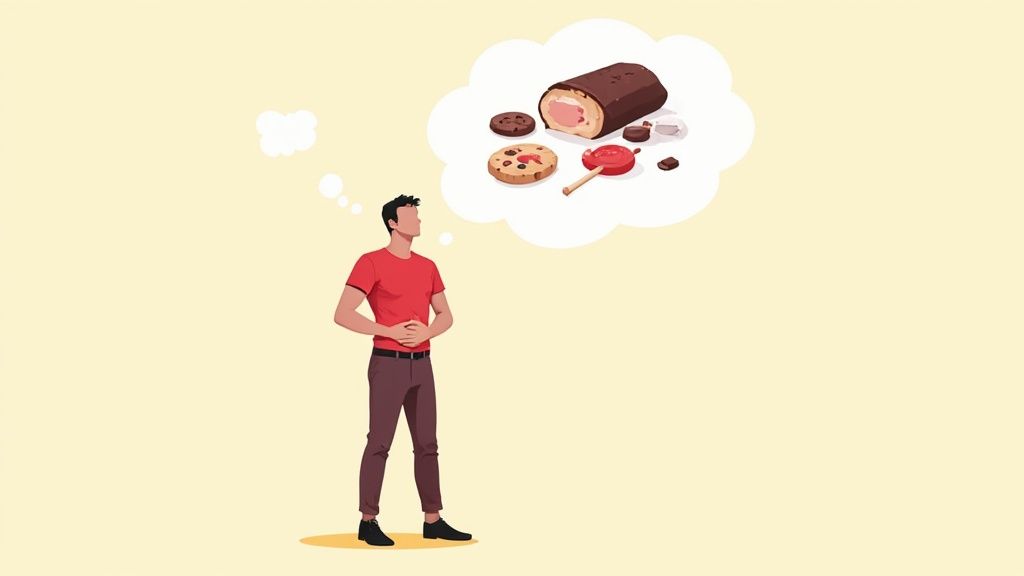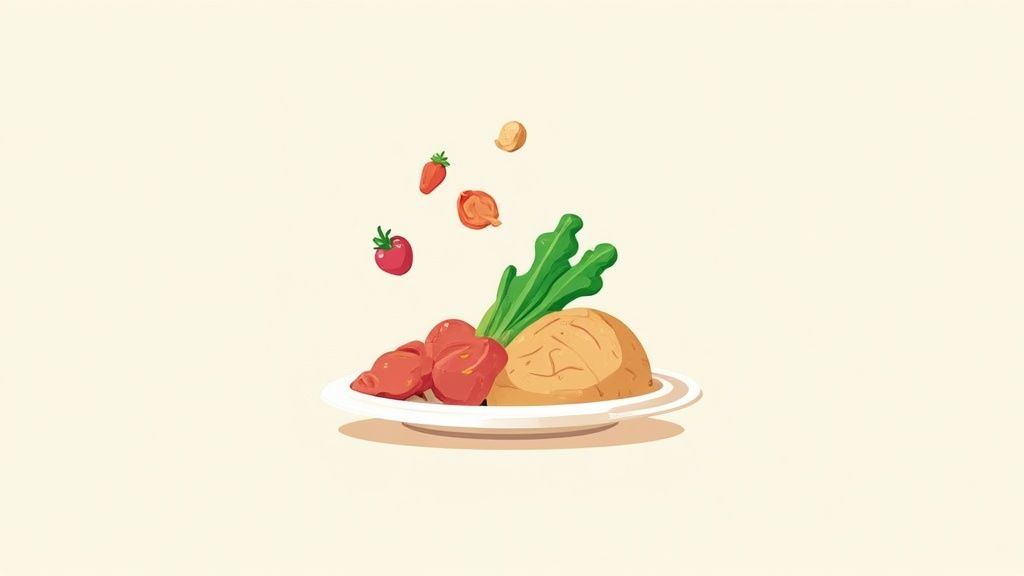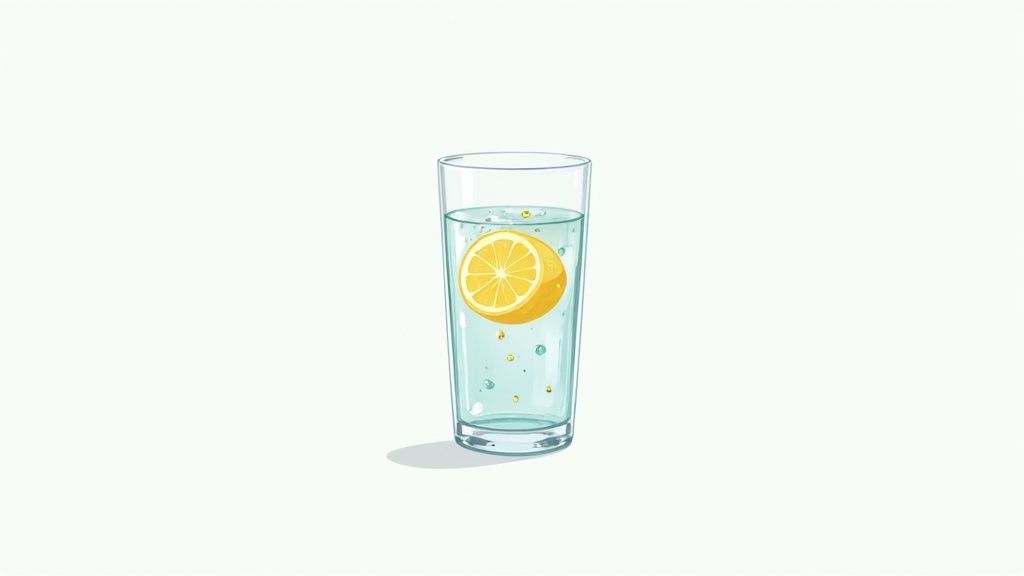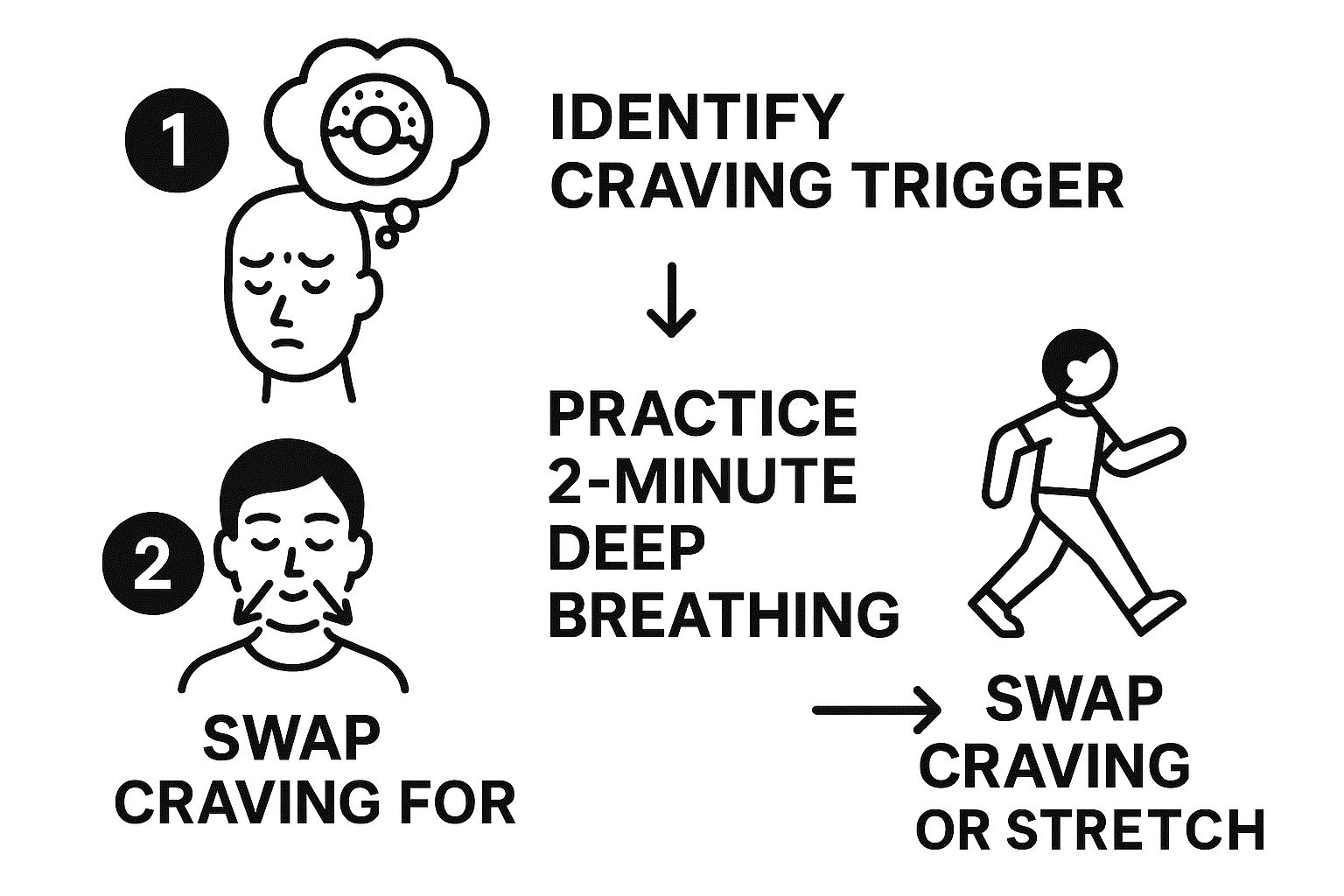How to Stop Sugar Cravings Naturally: Easy Tips & Tricks

If you've ever found yourself in a losing battle against a sugar craving, you know that willpower alone just doesn't cut it. That intense, can't-think-about-anything-else urge for something sweet isn't a sign of weakness. It's your body sending out a powerful biological signal that something is off-balance.
Instead of fighting those signals, what if we listened to them? A natural approach helps you get to the root of the problem, making cravings fade away on their own. It’s like finding and fixing a leaky pipe instead of spending all your energy mopping the floor.
Why Natural Methods Are Your Best Bet

Let's be real: trying to muscle your way through a sugar craving is exhausting, and it rarely works in the long run. The good news is that you don't have to. By understanding what's actually causing the craving, you can address it at the source. This is a much smarter, and frankly, more sustainable strategy.
Getting to the Root of Your Cravings
Most sugar cravings aren't random. They usually boil down to a handful of core issues that, once you know what they are, are surprisingly manageable with a few simple, natural shifts.
- The Blood Sugar Rollercoaster: When you eat something full of refined sugar or simple carbs, your blood sugar spikes, and you feel great... for a minute. Then it crashes, hard. That crash leaves you feeling tired, cranky, and desperate for another quick sugar hit to get your energy back. It’s a vicious cycle.
- Hidden Nutrient Gaps: Sometimes, a craving is just your body’s clever way of asking for a nutrient it’s missing. That desperate need for chocolate? It could actually be your body screaming for magnesium, a mineral that dark chocolate happens to be rich in.
- Stress, Emotions, and Habit: Ever notice how you reach for a cookie after a stressful day? That's cortisol, the stress hormone, at work. It makes you crave high-fat, sugary comfort foods. Many of us also fall into the habit of using sugar to deal with boredom, sadness, or even to celebrate.
How to Naturally Stabilize Your System
One of the most powerful things you can do is stabilize your blood sugar. When you eat meals that include plenty of fiber, protein, and healthy fats, you slow down the absorption of sugar and prevent those dramatic spikes and crashes.
For example, research has shown that simply starting your day with a balanced, protein-rich breakfast can slash mid-morning sugar cravings by approximately 30-40%. It sets a stable foundation for the rest of your day. The way we eat is influenced by where we live, and you can see this firsthand by exploring some fascinating insights on sugar consumption by country.
The goal isn't to declare war on sugar. It's to rebalance your body so that you are in control of your choices, not your cravings. Natural methods empower you to build sustainable habits for long-term success.
Your Quick Guide to Beating Cravings
Feeling a craving coming on? Here are the most effective natural strategies at a glance. Use this table for a quick reminder of what to do and why it works.
| Strategy | Why It Works | Quick Tip |
|---|---|---|
| Eat a Balanced Meal | Stabilizes blood sugar, preventing the crash that triggers cravings. | Include protein, healthy fat, and fiber. Think chicken salad or an apple with peanut butter. |
| Drink Water | Dehydration often masquerades as a sugar craving. | Before grabbing a snack, drink a full glass of water and wait 10 minutes. |
| Get Moving | A brisk walk or a few stretches can boost endorphins and distract you. | Go for a 15-minute walk outside. The change of scenery and fresh air work wonders. |
| Manage Stress | Lowers cortisol levels, which can drive cravings for comfort food. | Try deep breathing exercises, meditation, or listening to calming music for 5 minutes. |
| Eat Fermented Foods | A healthy gut microbiome can reduce sugar cravings. | Add a spoonful of kimchi or sauerkraut to your meal, or sip on some kombucha. |
Remember, consistency is key. Integrating these small habits into your daily routine will make a massive difference over time, putting you back in the driver's seat.
How to Build a Meal Plan That Kills Cravings

Let's be honest: what you eat is your best defense against sugar cravings. Forget relying on sheer willpower when your brain starts screaming for a cookie. A smart meal plan can prevent those cravings from even starting.
The secret is building meals that keep your blood sugar stable. It's those sudden, drastic dips in blood sugar that have you raiding the pantry for a quick, sugary hit. So, instead of just thinking about what to avoid, we're going to focus on what you should be eating.
Think of every meal as your chance to load up on protein, healthy fats, and high-fiber carbs. This powerful trio works together to slow down digestion and the release of glucose into your system, giving you long-lasting, steady energy. It's like building a fire: a piece of paper (sugar) flares up and dies out instantly, but a solid log (protein, fat, and fiber) burns slow and steady for hours. Your metabolism isn't so different.
The Power Trio: Protein, Fat, and Fiber
Let's quickly look at why this combination is your secret weapon for stopping sugar cravings naturally. Each one has a specific job to do.
- Protein: This is what truly makes you feel full and satisfied. It keeps you feeling that way longer than anything else you can eat and even gives your metabolism a slight nudge since it takes more energy to digest.
- Healthy Fats: Think avocados, nuts, seeds, and olive oil. These are crucial for slowing down how quickly your stomach empties, which prevents those nasty blood sugar spikes and the crashes that always follow.
- Fiber-Rich Carbs: We're talking vegetables, beans, and whole grains. Fiber also slows down sugar absorption and adds bulk to your meals, helping you feel full without piling on empty calories.
When you put these three on the same plate, you're creating a meal that brings balance to your body and your hormones. This is the foundation for breaking that exhausting craving cycle for good.
Putting It All on Your Plate
Okay, the theory is great, but what does this look like in real life? Let's take a typical breakfast and see how one simple swap can set the tone for your entire day.
Picture this: you start your morning with a bowl of sugary cereal and a glass of orange juice. That meal is loaded with simple sugars and has almost no protein or fat. Sure, you get an immediate rush of energy, but I guarantee by 10 a.m., you'll be crashing hard and eyeing the donuts in the office breakroom.
Now, imagine this instead: a smoothie blended with unsweetened almond milk, a scoop of protein powder, a spoonful of almond butter, and a handful of spinach. This breakfast checks all the boxes—protein, healthy fats, and fiber.
The difference is night and day. With the smoothie, that mid-morning slump just doesn't happen. You feel energized, focused, and can easily cruise through to lunchtime without even thinking about sugar. This is a perfect, real-world example of how to stop sugar cravings by getting ahead of them.
This same idea works for every single meal. Swap that plain pasta for a bowl loaded with grilled chicken, a drizzle of good olive oil, and some roasted broccoli. Instead of a bag of chips for a snack, grab a handful of almonds and an apple. It’s these small, consistent upgrades that create a rock-solid foundation for a life free from cravings, leaving you feeling full, energized, and totally in control.
The Surprising Link Between Gut Health and Cravings

It might sound a little strange, but the trillions of bacteria living inside your gut could be the real reason you can’t stop thinking about that cookie. This inner ecosystem, your gut microbiome, has a surprising amount of influence over everything from your mood to your immune system. And yes, it can even dictate what you crave.
How? It all comes down to the gut-brain axis, which is basically a direct communication line between your digestive system and your brain. When the balance of bacteria in your gut gets thrown off, they can send some pretty powerful messages up that line.
Certain types of "bad" gut bacteria absolutely love sugar—it's their favorite fuel. When these microbes multiply, they can actually send signals to your brain that demand more sugar, creating intense cravings that feel almost impossible to resist.
The wild part is that your cravings might not even be yours. They could be coming from microbes that just want you to feed them what they like best.
Taming Cravings by Taking Care of Your Gut
The great news is that you're not powerless here. You can absolutely shift the balance back in your favor. By feeding the "good" bacteria, you help them thrive and eventually crowd out the sugar-loving microbes. This is one of the most effective long-term strategies for kicking sugar cravings for good.
New research is constantly showing how changing our gut bacteria can help control these urges. A diet full of the right nutrients can promote the kinds of microbes that help manage the dopamine pathways linked to cravings and reward. If you want to dive deeper into the science, you can check out the latest findings on dietary sugar and the microbiome.
You can start rebalancing your gut right now by focusing on two types of foods: probiotics and prebiotics.
Your Gut-Friendly Food Guide
Think of it like this: Probiotics are the reinforcements. They're live, beneficial bacteria that you add directly to your gut's army.
You can find them in fermented foods like:
- Yogurt and Kefir: Always grab the plain, unsweetened kind with "live and active cultures."
- Sauerkraut and Kimchi: These tangy fermented cabbage dishes are fantastic. A small spoonful on the side of a meal is an easy way to get them in.
- Kombucha: A bubbly, fermented tea. Just make sure you're buying a low-sugar brand, as some can be packed with it.
Prebiotics, on the other hand, are the food for your existing good bacteria. They're specific types of fiber that help your friendly microbes grow strong and multiply.
Some great sources include:
- Garlic and Onions: Super easy to toss into almost any savory dish you cook.
- Bananas: They're especially potent when they’re still a touch green.
- Oats and Barley: Wonderful sources of soluble fiber that your gut loves.
- Asparagus and Leeks: These veggies are true prebiotic powerhouses.
You don't need to completely change your diet overnight. Just start small. Add a scoop of plain yogurt to your breakfast or a side of sauerkraut to your lunch. These small, steady steps give your gut what it needs to silence those sugar demands from the inside out, making your journey much, much easier.
Lifestyle Changes That Silence Your Sweet Tooth
What you eat is a huge piece of the puzzle, but what you do outside the kitchen often has an even bigger say in why you're craving sugar. Think of your body like a finely tuned instrument. When things like sleep, stress, and hydration are out of sync, the first note to go sour is usually your control over cravings.
It’s a story I hear all the time. You’ve eaten well all day, but a stressful afternoon at work or a single bad night's sleep leaves you staring into the pantry, ready to demolish an entire sleeve of cookies. This isn't a failure of willpower. It's your body's biological response to being over-stressed and under-rested.
Prioritize Sleep to Regulate Your Hunger Hormones
Sleep isn't a luxury. For anyone serious about kicking sugar cravings for good, it's completely non-negotiable. When you're running on empty, your body's entire hormonal system is thrown into chaos.
Your levels of ghrelin, the "hunger hormone," go through the roof, screaming at your brain that you need to eat. At the exact same time, leptin, the hormone that tells you you're full, takes a nosedive. This hormonal one-two punch creates the perfect storm for intense cravings, especially for the quick energy hit you get from sugary, high-calorie foods.
To get a handle on this, start with a simple evening wind-down routine:
- Set a consistent bedtime. Aim to go to bed and wake up around the same time every day—yes, even on weekends. This helps regulate your body's internal clock.
- Dim the lights. About an hour before bed, lower the lights and put away your screens. The blue light from phones and TVs can seriously mess with melatonin production.
- Unwind without a screen. Instead of scrolling, try reading a real book, listening to some calm music, or taking a warm bath.
Manage Stress to Calm Down Cortisol
Stress is another massive trigger for sugar cravings. When you're chronically stressed, your body is constantly pumping out the hormone cortisol. High cortisol levels send a powerful signal to your brain to seek out pleasure and reward, and there’s no quicker or easier fix for that than a hit of sugar.
You don't need a complicated, hour-long meditation session to make a real difference. Quick, in-the-moment stress management can be incredibly effective. The next time you feel that wave of stress rising, try a simple box breathing exercise: inhale for four counts, hold for four, exhale for four, and hold for four. Just two minutes of this can reset your nervous system and dial down those cortisol-driven urges. For more ideas, you might find our guide on 8 ways to reduce sugar cravings incredibly helpful.
Move Your Body to Rebalance Your Brain
Regular physical activity is one of the most powerful tools in your arsenal. Exercise does way more than just burn calories; it fundamentally changes your brain chemistry and improves how your body handles sugar.
Physical activity is a scientifically supported natural strategy to reduce sugar cravings. Exercise influences brain chemistry by increasing the release of endorphins and serotonin, which can diminish the desire for sugary foods.
In fact, controlled trials have shown that moderate-intensity aerobic exercise sessions lasting 30-45 minutes can slash sugar cravings by roughly 20-25% immediately after a workout. If you're curious about the bigger picture, you can review some insightful sugar production statistics to see how it all connects.
You don't have to live at the gym. A brisk 15-minute walk after lunch can do wonders for improving insulin sensitivity and crushing those afternoon cravings. The real key is finding movement you genuinely enjoy and making it a consistent part of your routine.
Mindful Ways to Manage Cravings in the Moment
Even with a perfect plan, a monster sugar craving can ambush you when you least expect it. This is where mindfulness becomes your secret weapon. It’s not about willpower; it’s about creating just a tiny bit of space between the urge and your reaction.
When that intense craving hits, take a breath and get curious. Ask yourself a simple question: "Am I actually hungry, or is this something else?"
Real, physical hunger tends to creep up slowly and isn’t too picky—an apple or a handful of nuts would probably do the trick. Emotional cravings, on the other hand, hit like a ton of bricks. They feel urgent and are laser-focused on one specific thing. You don’t just want a snack; you need that specific double-fudge brownie, and you need it now.
Just noticing this difference is a huge step. It puts you back in control, shifting you from being a passenger on the craving train to being the conductor. You aren't fighting the feeling, you're just getting to know it better.
Learning to Surf the Urge
One of the best ways to handle these intense, sudden urges is a technique called urge surfing. The idea is simple: instead of fighting a craving, which usually just makes it stronger, you learn to ride it out.
Think of your craving like an ocean wave. It slowly builds, reaches a peak, and then naturally fades away. Your job is to stay on your surfboard and ride it until it disappears. Most cravings, as intense as they feel, only last for a few minutes. If you can just sit with that discomfort for a short while, you’ll be amazed at how its power over you dissolves.
The next time a craving hits, give this a try:
- Acknowledge it: Simply say to yourself, "I'm feeling a really strong craving for sugar right now."
- Get curious about the feeling: Where do you feel it in your body? A knot in your stomach? Mouth watering? Just observe these physical sensations without judging them.
- Breathe: Take a few slow, deep belly breaths. This sends a calming signal to your nervous system and reminds you that you're in charge.
- Watch it pass: Keep observing as the craving peaks and then starts to fade, just like a wave washing back out to sea.
Practicing this builds some serious mental muscle. If you want to dive deeper, exploring different mindful eating exercises can give you even more tools for your arsenal.
Create Your Personalized Craving Toolkit
Knowing what sets you off is half the battle. Do you crave sugar when you're stressed? Bored? Tired? Once you pinpoint your personal triggers, you can build a personalized "craving toolkit." This is your go-to list of healthy distractions and alternatives you can grab instead of sugar.
A craving is just a signal. Instead of letting it signal a trip to the vending machine, you can train it to signal a moment of self-care.
This little infographic breaks down a quick, three-step process for handling those cravings that pop up when you're feeling stressed.

As you can see, the key is to rewire your automatic response. You’re not just denying the craving; you’re replacing it with a positive action that actually addresses the root of the problem, like stress.
Got Questions About Sugar Cravings? Let's Talk.
Making the call to slash your sugar intake is huge, but it almost always comes with a wave of questions. If you're wondering what's ahead or how to tackle the inevitable bumps in the road, you're not alone. Let's get into the nitty-gritty of the questions I hear all the time.
So, How Long Until the Cravings Actually Stop?
This is the big one, isn't it? The honest-to-goodness answer is that it's different for everyone. How quickly your cravings fade really depends on where you're starting from, your personal biology, and how consistently you stick with your new habits.
Most people tell me they feel a significant shift after about two weeks of being really mindful. That said, to truly break old patterns and feel like you've hit the reset button, it might take a few months. The key is to aim for progress, not some overnight miracle.
Patience is your superpower here. You're working to undo years of ingrained habits and literally retraining your brain and body. Small wins day after day are what create real, lasting change.
Some people feel pretty rough when they first cut down on sugar, almost like a withdrawal, which can make cravings feel even stronger for a little while. If that's a worry for you, getting familiar with understanding sugar withdrawal symptoms can make that initial phase a lot less intimidating.
What About Fruit? Is It Off the Table?
Absolutely not! Whole fruits are a fantastic part of this process. There’s a world of difference between a handful of berries and a candy bar. Fruits offer up their sweetness along with fiber, water, vitamins, and a host of other good things.
That fiber is the game-changer. It slows down how your body absorbs fructose (the natural sugar in fruit), which helps you avoid those wild blood sugar rollercoasters that fuel more cravings. Think of things like berries, apples, and even bananas as smart ways to satisfy a sweet tooth without derailing your efforts.
Do I Really Have to Quit Sugar Forever?
This journey isn't about sentencing yourself to a lifetime without a single sweet treat. It's about shifting the power dynamic. It's about you being in the driver's seat, not your cravings.
Once your system finds its balance again, you'll notice that you just don't feel that desperate pull anymore. You can decide to have a piece of birthday cake and actually enjoy it without that decision sending you into a week-long sugar binge. The goal is to make sweets a deliberate choice, not a desperate compulsion.
Here’s a simple way to think about the shift:
- Before: The craving was in charge.
- After: You are in charge.
This is a far more realistic and sustainable way to live than trying to follow a strict "never again" rule. It’s all about building a healthier, more relaxed relationship with food. And honestly, you'll probably find that your taste for intensely sweet things starts to fade all on its own.